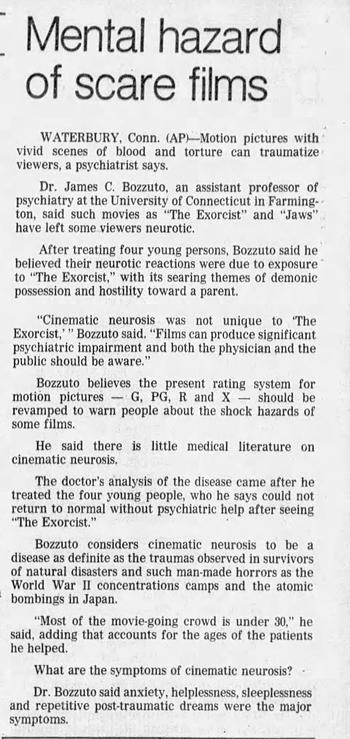Cinematic Neurosis
Following the 1973 release of The Exorcist, six people who saw it had to be admitted to a Chicago hospital "straight from the theater." Psychiatrist James Bozzuto examined four of them and concluded they were suffering from "cinematic neurosis" — a term he coined. Basically, this was neurosis caused by watching a movie. Symptoms of this condition included "anxiety, helplessness, sleeplessness and repetitive post-traumatic dreams."

The 1975 release of Jaws also caused an outbreak of cinematic neurosis. Here's a description of a case from a December 1975 Knight News Wire article:

San Francisco Examiner - Dec 14, 1976
The 1975 release of Jaws also caused an outbreak of cinematic neurosis. Here's a description of a case from a December 1975 Knight News Wire article:
Three months ago, a 17-year-old girl from a small town in western Kansas was admitted to Wichita's Wesley Medical Center with a strange malady. Her neck was stiff, her hands trembled, and she was periodically seized by fits of terror. She would jerk her arms spasmodically and scream, "Sharks! Sharks!"
During these attacks, which always occurred at night, she appeared to be unaware of the world around her, and she didn't respond when people spoke to her.
Over the next three days, while doctors ruled out the possibility that she had meningitis or some other neurological problem, she had five of these attacks.
In between these episodes of terror, she talked with neurologist Arnold Barnett about her problem.
It seems that three days before admission, she had seen the motion picture "Jaws," movie history's biggest money-maker, which chronicles the bloody activities of a shark that terrorizes swimmers off the shores of Long Island.
Later that evening, after discussing the film with her friends, she became frightened and upset. She had her first attack the next day.
Barnett treated the girl with sedatives and reassuring conversation. He emphasized the unlikelihood of a shark attack in western Kansas.
During these attacks, which always occurred at night, she appeared to be unaware of the world around her, and she didn't respond when people spoke to her.
Over the next three days, while doctors ruled out the possibility that she had meningitis or some other neurological problem, she had five of these attacks.
In between these episodes of terror, she talked with neurologist Arnold Barnett about her problem.
It seems that three days before admission, she had seen the motion picture "Jaws," movie history's biggest money-maker, which chronicles the bloody activities of a shark that terrorizes swimmers off the shores of Long Island.
Later that evening, after discussing the film with her friends, she became frightened and upset. She had her first attack the next day.
Barnett treated the girl with sedatives and reassuring conversation. He emphasized the unlikelihood of a shark attack in western Kansas.
Comments
One advertising slogan they come up with in 'Crazy People (1990) is: "Paramount Pictures presents 'The Freak.' This movie won't just scare you, it will ph**k you up for life."
I guess studios didn't pursue that line of audience reaction.
I guess studios didn't pursue that line of audience reaction.
Posted by Phideaux on 09/22/20 at 03:45 PM
Commenting is not available in this channel entry.

Category: Bad Habits, Neuroses and Psychoses | Movies | Psychology | 1970s